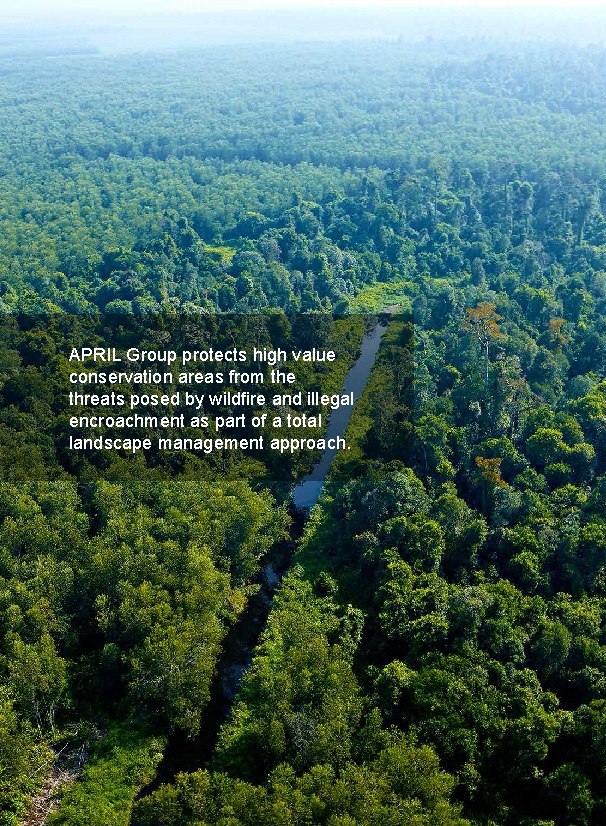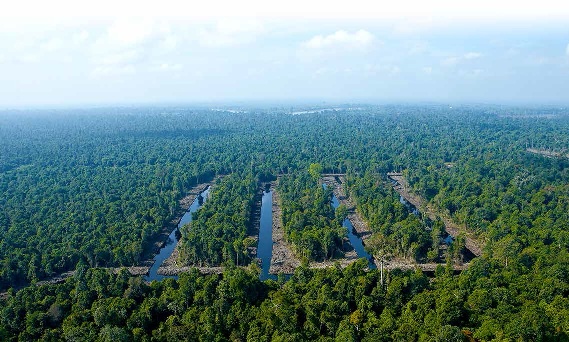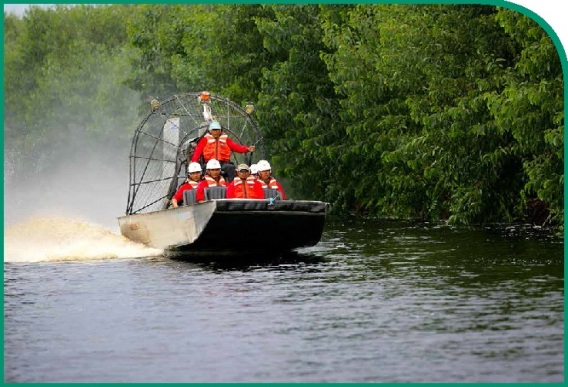In Riau province, peatland comprises 4 million hectares, or 45 percent of the province’s total land area, according to the Ministry of Environment and Forestry.
The east coast of Sumatra is characterized by low-lying flatlands with coastal and riverine peat swamp forests and recent alluvial deposits. These environments are less productive to settle and develop for conventional agriculture, so traditional settlements have been confined to the accessible riverside periphery. As such, intensive land use and clear land use ownership have been lacking.
In the last forty years, Riau Province has been intentionally populated by various Governments through migration schemes under a so called ‘transmigration project’. Resources and technology as well as population pressure have created development challenges. Today, Riau Province has transformed into an emerging economy based almost entirely on land-based industry. The rapidly growing population (4 percent per annum according to Government statistics) has placed increasing pressure on natural resources. Almost all mineral soil lands that are arable have been developed for agriculture. Development in Riau has been promoted by successive central and provincial Governments – including through the issue of commercial licenses for forestry. This reflects an economic focus on an industry that creates sustainable employment and local economic contribution.
Companies including APRIL Group are licensed to develop heavily cut-over areas of natural ‘State Production Forest’, i.e., forest degraded by previous logging activity and where the peat soils have been degraded by unsustainable slash and burn and illegal logging practices by local communities expanding onto peatland. In new development, planting of fast growing, actively managed timber plantations takes the place of degraded natural forest that has been beyond resources of the state to police and protect. To ensure the
sustainable management of this landscape, APRIL Group has committed to match each hectare of plantation with a hectare of protected natural forest.
License holders have a responsibility to ensure they balance community livelihood and social development issues with environmental protection. For local communities, human development is an essential condition of sustainability. APRIL Group protects high value conservation areas from the threats posed by wildfire and illegal encroachment as part of a total landscape management approach. At the same time, our sustainable plantation forestry creates livelihood and economic opportunities, presenting a sustainable alternative to subsistence agriculture and economic marginalization for local communities. At the same time, the plantations function as buffer for conservation and protection from encroachment and fire.
Peatland biophysical properties offer unique benefits as well as additional responsibilities. Peatland is naturally high in organic matter and available moisture supporting highly productive tree farms that create a competitive advantage for Indonesian forestry. At the same time, a total landscape management approach featuring plantation buffer zones that surround conservation forest are a proven way to conserve peat swamp forest domes and riparian corridors from the encroachment, drainage and fire of the present day pressure to secure land as traditional agriculture spills over onto the only land left – coastal peatland. This pressure will ease as the local economy matures and diversifies.
When peatland is managed wisely and with caution, the risks to the environment in the present day social context are reduced compared to unmanaged areas of forest. In this way we are committed to ensuring the protection of sensitive peatlands through sustainable plantation management strategies that incorporate fire prevention and suppression, landscape protection as well creating local economic opportunity.

CONSERVING PEATLAND
APRIL Group’s approach to effective and sustainable peatland management is based on balanced land use – including meeting the rising demands of local people for wellbeing benefits. Degraded landscapes are developed into productive tree farms that create a physical buffer to protect conservation forest. At the same time, the revenue generated supports the protection of substantial areas of set-aside sensitive peat dome. Land use allocation is based on robust High Conservation Value (HCV) assessments that incorporate best available science – and on open consultation with public stakeholders.
HCV assessments identify the highest, most appropriate opportunities to effect real conservation on the ground - as part of a holistic approach to landscape planning. Landscape planning tools include biophysical survey, fire management and hydrology assessment. The implementation of a professionally managed plantation buffer reduces the risks, which can be considerable and constant - of encroachment and degradation by traditional slash and burn.
WATER MANAGEMENT
In order to maximize plantation growth conditions and to minimize the environmental impact associated with peat land development (i.e., greenhouse gas (GHG) emissions from peat degradation), land use planning is the primary tool. The objective is to conserve nature where it has the best chance of success and to develop the most degraded areas into plantations. On a finer scale, structural interventions such as water control structures are the secondary tool. Landscape planning involves protection and buffering of central peat domes and other sensitive sites to guard against drainage impacts.
In Riau, Indonesia, rainfall varies seasonally from anywhere between 50mm per month during less wet periods to more than 500mm during super wet months. We therefore closely monitor this variation and practice management interventions for the purpose of fire prevention and fire suppression management.
APRIL Group’s water management is planned at a landscape scale and thereafter is implemented at the detailed scale by water control weirs that optimize ground water levels to control carbon emissions.

ELIMINATING FIRE RISK
The burning of peat results in the emission of carbon dioxide, a greenhouse gas and also a major health issue to humans both within and outside of Riau Province. Accordingly it is crucial to do everything to avoid fires on peatland areas. Fire prevention efforts are much more effective than suppression.
APRIL Group has a zero tolerance approach to fire within its concession lands and enforces the same standards among its suppliers. We invest heavily in fire prevention schemes and incentives for local communities, and in fire suppression capabilities. We also engage with local communities on education and incentive-based prevention initiatives.
APRIL Group works hard to collaborate and seek professional advice from leading national and international scientists in the fields of hydrology, conservation and greenhouse gas emissions monitoring to advance our understanding of peatland management. We engage external experts to evaluate and strengthen long-term peatland management strategies with an emphasis on carbon reduction in line with our conservation objectives. APRIL Group regularly consults the Stakeholder Advisory Committee (SAC) on environment policy and on practices to enhance sustainability of operations.
